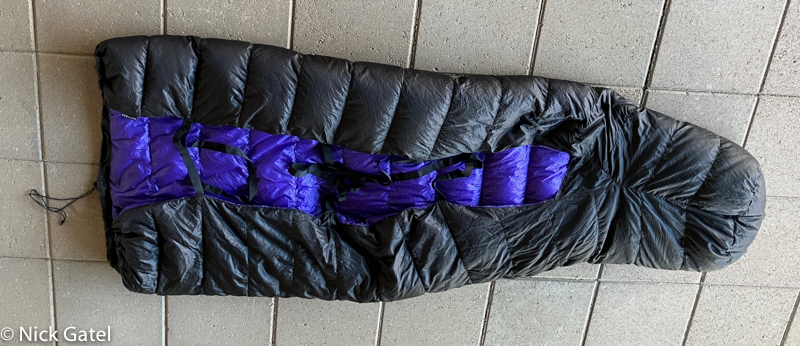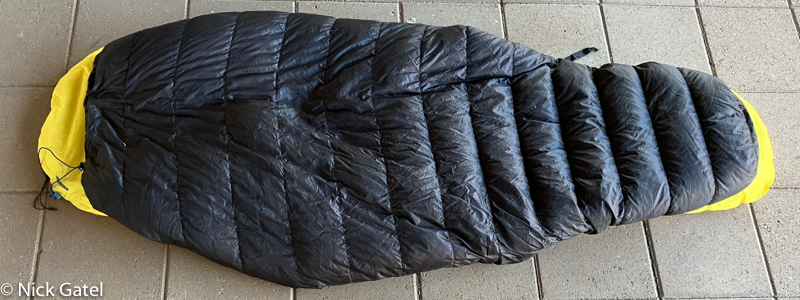
Yes, backpacking quilts can work well for side-sleepers, but it depends on personal preference and the specific design of the quilt.
For side-sleepers, the key consideration is the design of the quilt and how it accommodates different sleeping positions. Some backpacking quilts come with features like straps or snaps that can be used to secure the quilt around the sleeper, providing a more secure fit and prevent drafts. These features can be adjusted to allow freedom of movement for side-sleeping.
But first, for those who are not familiar with backpacking quilts, an overview of these specialized backpacking sleeping systems needs our attention.
What is a Backpacking Quilt?
Backpacking quilts are an alternative to traditional sleeping bags and are known for being lightweight and versatile.
Instead of being shaped like a large bag, the bottom (under the body) is open and works like the quilt on your bed at home. To minimize drafts, the bottom of each side is tucked under the body and usually secured with straps on each side of the quilt. There is usually a drawstring at the very top to secure the quilt snuggly above the shoulders.

Theory
Since the insulation (especially down insulation) on the bottom of a conventional sleeping bag is compressed by the weight of the user, the insulation value is diminished. For more a in-depth discussion of insulation loft (thickness) and ambient temperature, see my post, Understanding Layers Using Patagonia Clothing . . .
I must point out that any lofting material over 1/8” in thickness does provide some insulation. So a sleeping bag will have some insulation value on the bottom; it isn’t zero. With any sleep system, especially a quilt, an adequate rated insulation pad needs to be part of the sleep system. I don’t know any backpacker who does not use some sort of a pad under their sleeping bag or quilt, except for those who sleep in a hammock.
Quilts don’t come with hoods like those found on a mummy sleeping bag. A sleeping bag hood is a single use item — it is integrated into the bag — the backpacker will need a separate piece of headwear in cold weather when not sleeping. With a quilt, this separate piece of headwear becomes a multi-use item when worn when sleeping.
Without the extra insulation and fabric below the sleeping backpacker, the lack of a hood, and often no zippers, quilts are lighter take up less volume in the pack than a comparable sleeping bag of the same temperature rating.
Quilt Challenges for the Side-sleeper
Most side-sleepers move around at night, turning from side to side. This night movement in a quilt requires the quilt to stay in place when the side-sleeper changes their sleeping position under the quilt, otherwise cold drafts will enter the sleep system. With a conventional sleeping bag, the sleeper along with the sleeping bag itself can change position.
As you can see, quilts are ideal for those who sleep on their backs. Backpackers who sleep on their stomach often need a longer quilt because of how their feet stick out.
This doesn’t mean quilts are only for those who sleep on their backs or stomachs. What is important for the side-sleeper is to have enough girth in the quilt to turn over without creating drafts. Another consideration is the amount of girth has to be wide enough that a shoulder pressing against the top of the quilt doesn’t compress the insulation — the quilt needs to somewhat loosely drape over the sleeper — a side sleeper will need a larger girth than a back sleeper with the same size girth.
Girth — What is it?
Usually it is the circumference around the widest part of the shoulders, which works for most men. Manufacturers often use a specification named “shoulder girth.” But this doesn’t work for many women or some men. So we want to measure the widest part of our body.
Most back-sleepers will want a quilt width about 6 inches longer than their girth. Side sleepers 8 or 10 inches. For a cold weather quilt additional girth is often required.
Girth and Sleeping Pad Considerations
Some quilt users like to run the straps of their quilt under a sleeping pad to help keep the quilt secure. The width and height of the pad must be taken into consideration when determining what size girth to buy. In addition, the shape of the quilt should accommodate the sleeping pad’s shape and width.


I find that I sleep warmer if I do not run the straps under the sleeping mat.
My shoulder girth is 43 inches (I’m skinny!). The girth width of my Nunatak Arc Specialist quilt is 52 inches or 9 inches more. The quilt is rated for 32° F. As I wrote in my review of the Zpack 20° F Classic Sleeping bag, I rarely use it for temperatures under 50° F. One reason is I sleep cold and another is that at colder temperatures it is just too much work for me to avoid drafts during the night.
I have used the Nunatak quilt at colder temperatures and stayed warm. On a trip a few years ago, I slept in this basin where the temps dipped below freezing.

I slept warm with my quilt combined with a very light down jacket. It wasn’t a great night’s sleep as I woke a couple times to re-tuck the quilt under me. So for me, there is just a little too much fiddle factor for using a quilt near its temperature rating. Besides, my zPack 20° F Classic Sleeping Bag, which really isn’t a 20° bag for me, only weighs 3.2 ounces more than the 32° quilt.
The width and shape of the quilt can impact comfort for side-sleepers. Some quilts are designed with a wider cut or additional fabric to allow for more coverage when sleeping on one’s side.
Most quilt manufacturers are smaller companies and do customize their quilts along with various off-the-shelf sizes. They can help you size a quilt that will fit your needs.